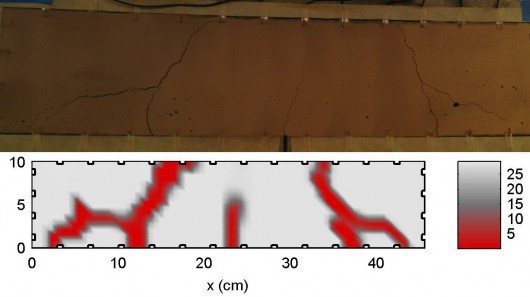
Although concrete structures such as bridges are now often built with strain sensors embedded within them, that certainly hasn't always been the case. In order to alert authorities to cracks developing within these older structures, one solution involves attaching sensors to them. Researchers from North Carolina State University and the University of Eastern Finland are working on an alternative, however – an electrically-conductive paint-on "sensing skin."
 Although concrete structures such as bridges are now often built with strain sensors embedded within them, that certainly hasn't always been the case. In order to alert authorities to cracks developing within these older structures, one solution involves attaching sensors to them. Researchers from North Carolina State University and the University of Eastern Finland are working on an alternative, however – an electrically-conductive paint-on "sensing skin."
Although concrete structures such as bridges are now often built with strain sensors embedded within them, that certainly hasn't always been the case. In order to alert authorities to cracks developing within these older structures, one solution involves attaching sensors to them. Researchers from North Carolina State University and the University of Eastern Finland are working on an alternative, however – an electrically-conductive paint-on "sensing skin."
In order for the skin to be able to do its job, a series of electrodes must first be installed around the perimeter of the structure. The skin is then applied in paint form, covering both the electrodes and all the surface area between them. The liquid contains conductive materials like copper, allowing electrical currents to flow through it.
Once the paint has dried and the system is up and running, a computer program systematically runs a weak current between two of the electrodes at a time (via the skin between them), systematically going through a variety of pairings of electrodes.
If any cracks have formed in the concrete since the paint was applied, it will negatively affect the skin's overall conductivity. Using algorithms to analyze and compare changes in the electrical potential of the electrodes, it's possible to not only detect these losses in conductivity, but to pinpoint the location of the cracks or other faults that are the cause.
A paper on the research was recently published in the journal Smart Materials and Structures.
A similar sensing skin has been developed at MIT, while the Queensland University of Technology has created a nanocomposite material that could likewise be applied to concrete surfaces.

 Previous page
Previous page Back to top
Back to top







